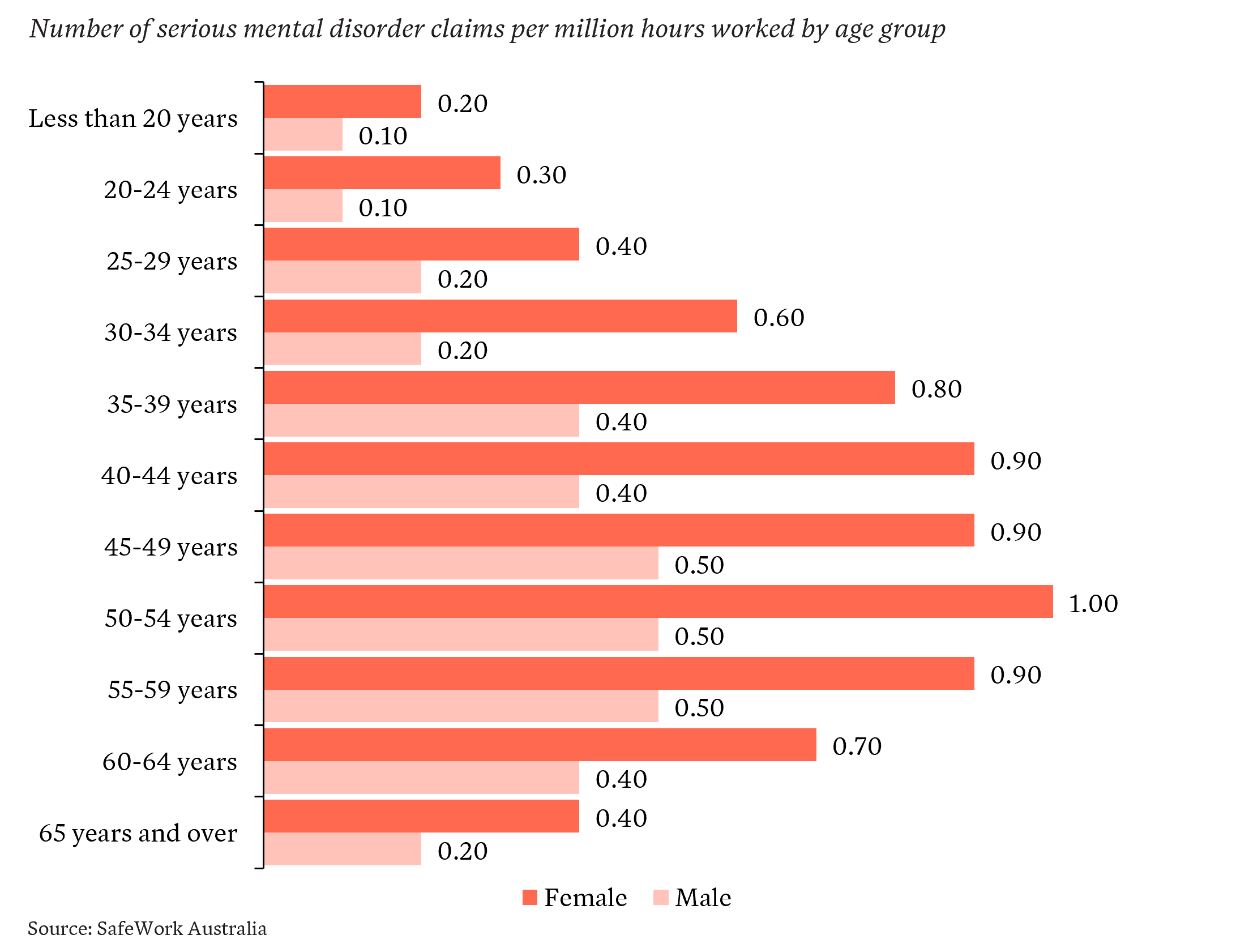Workers compensation and our ageing workforce


Australians are expected to live longer than ever before and in better health, which means many of us will work for more years and retire later. What are the impacts for workers compensation? We explore the unique challenges and opportunities for governments and society posed by our ageing workforce.
Over the next 40 years, the number of people aged over 65 is expected to double, while the number of people aged over 85 is expected to triple, according to the Australian Government’s latest intergenerational report.

People over 65 are more likely to prefer working part time and may seek less physical jobs
Not only are Australians expected to live longer, but they’re also expected to spend more years in good health. With better health and longer life expectancy, many Australians will spend more years working and retiring later. There are several reasons for this, including:
- Sharp and ongoing increases in cost of living
- To help stay mentally and physically active
- To accumulate higher savings for when physical work is no longer possible, which may contribute to maintaining standards of living in retirement
- To help provide financial support to family for longer.
Analysis conducted by the Australian Institute for Health and Welfare suggests that increased workforce participation is already happening for older people. Average workforce participation for over-65s has increased from 10.6% in 2010 to 14.8% in 2021. This has been observed for males and females.
Research published by Macquarie Business School, has recommended further increases to the age pension eligibility age, from the current legislated amount of 67 years up to 70 years by 2050. While the government has not yet announced any intention to further increase the age pension age, it’s no doubt a useful lever for it to manage the costs of a larger Australia (about 40 million by 2062) and an older population.
With people expected to live and work for longer, we’re likely to see a continuing ageing of the Australian workforce. This will bring some unique challenges for workers compensation systems.
Older workers – Needs vs risks
As workers age, the type of work the choose to do also changes. For example, people aged over 65 are more likely to prefer working part time than full time. Similarly, older workers may shift from more physically intensive jobs towards desk . It’s important for schemes and employers to understand changes in the mix of their employees over time and how that could impact employee exposure to injury and ability to return to work.
Understanding claimant patterns
Analysis published by Workcover WA indicates that workers aged over 55 are 50% more likely to lodge a workers compensation claim than workers aged 15-34. There may be several reasons for this, including:
- Older people can be more susceptible to injuries, particularly slips and trips and bodily stress, as a higher proportion of older workers suffer from chronic health conditions
- Experienced workers may be less worried about burning bridges with their employer by making a claim.
Separate analysis published by SafeWork Australia in 2015, states that workers over 40 are more likely to be compensated for a work-related mental injury condition than workers under 40. This has been observed for both males and females, as the chart shows below.

Older workers are more likely to claim for different types of injuries, including psychological
While the frequency of serious mental disorder claims seems to be highest for middle-aged workers (40-59 years), the frequency for older workers (over 60 years) is notably higher than the frequency for younger workers (24 years and under). SafeWork Australia further notes that older workers (over 55 years) had a 128% higher chance of being awarded a mental disorder claim as a result of work pressure compared to workers aged 24 years and under.
A unique risk profile
These analyses indicate that older workers have a unique risk profile and are more likely to claim for different types of injuries (across both physical and psychological injuries), compared to younger workers. A shift towards an older working population will therefore likely result in a change in the frequency and mix of types of injuries.
Publicly available research from other schemes is limited, however it’s likely that other schemes may be facing the same changes, particularly larger schemes covering a wide range of industries and workers. Different industries are likely to have different worker age and occupation profiles and therefore the impact of an ageing workforce is likely to differ across industries.
Look beneath the surface of return-to-work rates
There may be several contributing factors and reasons return to work can be difficult for older workers, including:
- Less effective rehabilitation for people with chronic health conditions
- A higher propensity for mental injuries, which have worse rates of return to work
- It may be more difficult to find suitable duties for older workers to return to
- People towards the end of their working career may have less incentive to return to work.
“A shift towards an older working population will likely result in a change in the frequency and mix of types of injuries.”
Higher claims incidence and poorer return-to-work rates may put more pressure on the financial stability of workers compensation schemes, however it’s important to assess the impact of an ageing claimant base on different benefit types. For example, incapacity benefits typically cease once a worker reaches the age pension age, whereas medical benefits usually extend beyond this age. There may be less pressure on incapacity benefits, with more claimants above the age pension age, but this might be offset by increased pressure on medical benefits.
Forward-thinking approach to gain the benefits
More research is needed to understand the impacts of the ageing workforce to date, in particular to identify if there’s a notable correlation between worker age and costs of workers compensation claims. It’s important schemes collect detailed data on age profiles of employees as well as claimants. This will support analysis of claims incidence, claims cost and return-to-work rates by worker age and occupation.
It’s likely employers and industries will need to reform their occupational health and safety procedures to account for their older workforce and the associated risks.
Governments could consider scheme changes to better address the needs of an ageing workforce, such as:
- Increased focus on injury prevention and effective rehabilitation
- Better management of long-term injured claimants
- Assessing whether the current level of cross-subsidisation of premiums between employers with a younger workforce versus an older workforce is still appropriate.
Despite the issues with an ageing workforce, research in recent years has explored the benefits of hiring older workers, such as higher levels of skills and experience, more employer loyalty and lower workplace absenteeism. By investing more in research and proactively designing scheme changes, Australia will be well placed to maximise its benefits from the ageing workforce, while minimising its risks.
Related articles
Related articles
More articles

RADAR FY2023 – Biggest profits since 2014, but affordability threatens sustainability
RADAR FY2023, Taylor Fry’s annual general insurance rundown in what’s been a turbulent and nuanced FY2023 for the industry
Read Article

COVID-19: What’s really driving CTP costs?
Pressure is on insurers to discount premiums, but the proposition is far more complex than it seems and the devil is in the details
Read Article







